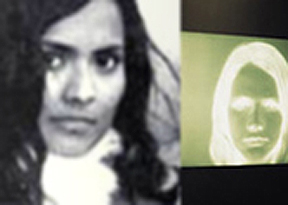
ART/London
"Lilith"
Through August 13th
As an entity, a theme, and a mythical figure, Lilith appears in a number of different forms across various religions, albeit under different names. Lilith is both inspiration and giver of knowledge, the strong autonomous woman; at the same time, she's often portrayed as a night demon that strangles babies, possesses young women through mirrors and seduces men away from their wives.
Jewish myth casts Lilith as made of the same dust, at the same time as Adam; she refuses to be his inferior and uses her superior knowledge and ability to escape the paradise of Eden. God is unable to persuade her to return, and molds Eve from the rib of Adam. Lilith is the embodiment of artistic and spiritual rebellion - a creation which refuses its intended purpose, rebelling against its creator's authorship.
What interested MOT about this myth are the stark, oppositional interpretations and subsequent appropriations (and misappropriations) inherent in a single word: Lilith.
MOT looked for work that questions its own nature and its own material make-up; the works on display offer the viewer ambiguous readings, satisfying and frustrating external expectation and interpretation.
The artists:
Sonia Boyce's own image disappears from her reflection; she is the creator of her work, but wholly absent in its display; instead, it is her collaborators - their voices and music -- that are presented to the hearer.
Boyce presents "we meet through you": two separate CDs of two singers, Martin and Jinya, singing three different songs each, which are accessed through one set of headphones. The singers' voices are streamed through the headset - one on the left, one on the right.
The two singers have never met, yet their voices come together in the head of the listener, who can alternatively separate or blend together two different streams of information. Martin and Jinya's photographic portraits are the only other piece of biographical information given to the viewer.
Louise Harris employs traditional crafts; such as watercolor painting or felt making, commonly associated with arts and crafts/the domestic realm, to render portraits of intriguing women and religious scenes. Harris steps over the border between craft and art, transcending the limits of materials through the scale and subject of each piece.
Runa Islam explores the nature of film, examining its narrative structure and relationship to reality. Although she works with a variety of mediums, film has a significant place in her work; adept at filmic language and limitations, she constructs analytical and evocative installations tied to the mental processes of sensual experience.
A number of her pieces study the nature of the look or gaze; her work produces a shifting of perception as our gaze is returned by the image, blurring the line between the viewer's life, and the life being viewed.
When invited to exhibit, Islam expressed an interest in the role of the mirror within the Lilith myth, seeing a link to her own work. She will be showing "Unreconciled," a video of a young woman with her back turned to the camera. Shot in one-minute episodes, the women never turns, her look -- and some measure of knowledge about her -- denied to the viewer.
[Shown: l: Runa Islam; r: detail, "(Stare Out) Blink", (1998), 16mm film installation, Runa Islam]
Find it: MOT
Unit 54/5th floor Regents Studios
8 Andrews Road London E8 4QN
Hours: Fri-Sun, 12 noon - 5pm, or by appt.
Get there: Bethnal Green Underground Bus 394,106,253,26,48,55,D6, D3, 8
Get info: Tel: +44 (0)207 923 9561 Mob: +44 (0)7931 305 104
Find other art exhibits worldwide, in the August 2004 issue of "Arte Six".

<< Home